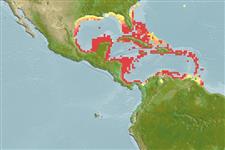>
Eupercaria/misc (Various families in series Eupercaria) >
Labridae (Wrasses) > Corinae
Etymology: Thalassoma: Greek, thalassa = the sea + Greek, soma = body; the colour of the sea (Ref. 45335).
More on author: Bloch.
Environment: milieu / Zona climática / intervalo de profundidade / distribution range
Ecologia
marinhas associadas(os) a recifes; intervalo de profundidade 0 - 40 m (Ref. 9710), usually 3 - 30 m (Ref. 27115). Tropical; 23°C - 26°C (Ref. 27115); 34°N - 7°N, 99°W - 58°W
Western Atlantic: Bermuda, Florida (USA), southeastern Gulf of Mexico and throughout the Caribbean Sea to northern South America.
Tamanho / Peso / Idade
Maturidade: Lm ? range ? - ? cm
Max length : 25.0 cm TL macho/indeterminado; (Ref. 26340); idade máx. registrada: 3.00 anos (Ref. 3420)
Espinhos dorsais (total) : 8; Raios dorsais (total) : 12 - 13; Espinhos anais: 3; Raios anais : 10 - 11. Body elongate; 3 primary color phases, the smallest with a black mid-lateral stripe which continues as pale red blotches on head; back above stripe yellow on reef fish and whitish on fish from inshore non-reef areas, and body below white. The largest phase, has a bright blue head and a green body with two broad vertical black bars anteriorly which are separated by a light blue interspace; this phase is always male. The small yellow phase with the black stripe may be either male or female (Ref. 13442).
Body shape (shape guide): fusiform / normal.
Inhabits reef areas, inshore bays and seagrass beds. Feeds mainly on zooplankton and small benthic animals, but may also feed on ectoparasites of other fishes (Ref. 9626). Spawn at midday throughout the year (Ref. 26938). A protogynous hermaphrodite (Ref. 55367). Generally of no interest to fisheries because of its small average size (Ref. 5217).
Ciclo de vida ou comportamento de acasalamento
Maturidade | Reprodução | Desova | Ovos | Fecundidade | Larvas
A diandric species (Ref. 55367). Sex reversal is completed in more than 3-4 weeks (Ref. 34185, 34257). Length at sex change = 8.3 cm TL, forms leks during breeding (Ref. 55367).
Robins, C.R. and G.C. Ray, 1986. A field guide to Atlantic coast fishes of North America. Houghton Mifflin Company, Boston, U.S.A. 354 p. (Ref. 7251)
Status na Lista Vermelha da UICN (Ref. 130435: Version 2025-1)
Ameaça para os humanos
Harmless
Uso pelos humanos
Pescarias: espécies comerciais; Aquário: Espécies comerciais
Ferramentas
Relatórios especiais
Baixar XML
Fontes da internet
Estimates based on models
Preferred temperature (Ref.
123201): 25 - 28.1, mean 26.8 °C (based on 222 cells).
Índice de diversidade filogenética (Ref.
82804): PD
50 = 0.5000 [Uniqueness, from 0.5 = low to 2.0 = high].
Bayesian length-weight: a=0.00912 (0.00526 - 0.01582), b=3.02 (2.88 - 3.16), in cm total length, based on LWR estimates for this species & Genus-body shape (Ref.
93245).
Nível Trófico (Ref.
69278): 3.3 ±0.1 se; based on diet studies.
Generation time: 1.5 ( na - na) years. Estimated as median ln(3)/K based on 1
growth studies.
Resiliência (Ref.
120179): Elevada, tempo mínimo de duplicação da população menor que 15 meses (k=0.7; tmax=3).
Fishing Vulnerability (Ref.
59153): Low vulnerability (20 of 100).
🛈
Nutrients (Ref.
124155): Calcium = 75.2 [45.5, 123.9] mg/100g; Iron = 0.761 [0.447, 1.351] mg/100g; Protein = 18.6 [15.8, 20.8] %; Omega3 = 0.149 [0.100, 0.227] g/100g; Selenium = 32 [20, 56] μg/100g; VitaminA = 77.7 [25.7, 279.6] μg/100g; Zinc = 1.51 [1.07, 2.36] mg/100g (wet weight);
